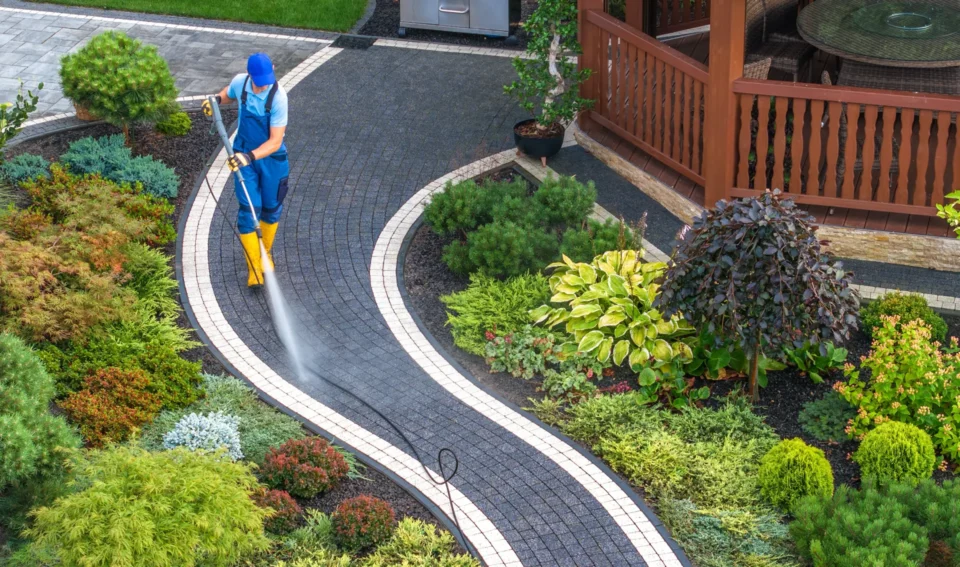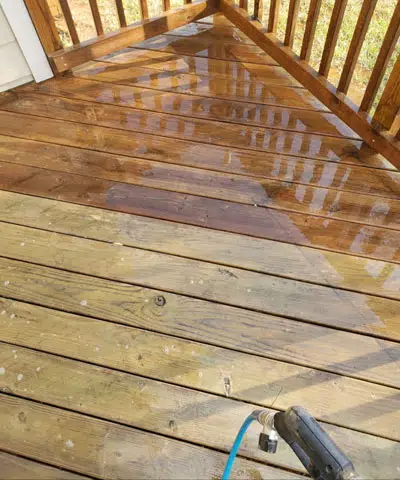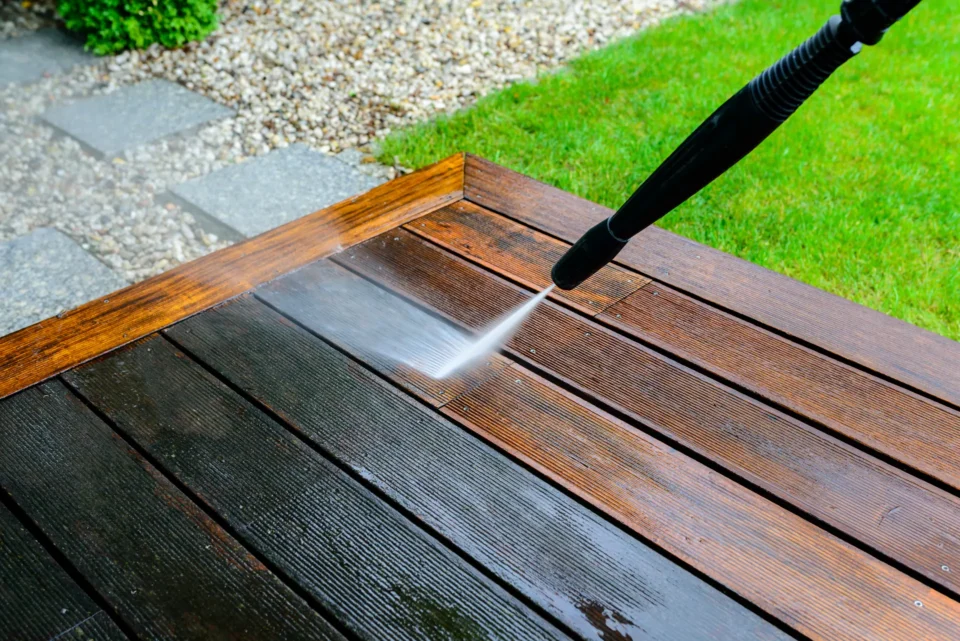It’s happened to all of us. You spend hours scrubbing, sweeping, or even pressure washing your sidewalk, hoping for that pristine, clean surface that enhances your home’s curb appeal. Yet, despite your efforts, those stubborn stains refuse to budge.
Whether it’s oil stains from a leaking car, rust from outdoor furniture, or mysterious dark spots, those blemishes on your concrete walkway can be frustrating. But have you ever wondered why some stains simply refuse to come off, no matter how much elbow grease you put in?
Why Do Some Sidewalk Stains Stay Even After Pressure Washing?
You may have tried to remove sidewalk stains with your trusty pressure washer, only to find that some stains remain. If you’ve been perplexed by why certain stains cling to the surface despite high-powered cleaning, you’re not alone. Pressure washing can do wonders for general dirt and grime, but it often falls short when it comes to stubborn stains. So, why is that?
1. Stains Seep Into the Concrete
Unlike other surfaces, concrete is porous, meaning it can absorb liquids over time. When oil, rust, or other substances seep into the surface, they penetrate the small pores in the concrete, making them harder to remove.
Pressure washing is effective for removing dirt and surface-level stains, but it struggles to reach deep inside the concrete pores. As a result, stains that have already settled into the surface often remain, even after a thorough cleaning.
2. Concrete Texture
Concrete sidewalks often have a rough, textured surface. This texture provides more area for stains to cling to, which makes them more difficult to clean. The more textured the concrete, the more likely stains are to get trapped in the grooves, requiring specialized cleaning methods to fully remove them.
3. Inadequate Pressure or Technique
Not all pressure washers are created equal. If the pressure is too low or the technique isn’t up to par, even the best equipment may not be able to dislodge stubborn stains. Some stains may require a combination of high-pressure washing and the use of specialized detergents designed to break down specific substances like oil or rust. If the stain is old or deep-set, pressure washing alone may not cut it.
What Causes Deep Discoloration on Concrete Sidewalks?
Deep discoloration on sidewalks can be caused by various factors, ranging from the type of substance that caused the stain to the age and condition of the concrete. Understanding what contributes to these deep stains can help you figure out how to tackle them effectively.
1. Organic Stains (Moss, Algae, and Leaves)
One common cause of discoloration is organic matter such as moss, algae, and decaying leaves. Over time, these substances break down and leave stains that can discolor the concrete. Organic stains are often darker and can seep deep into the surface of the sidewalk, especially in areas that are shaded or have poor drainage.
2. Oil and Grease Stains
Oil and grease stains, often from vehicles, barbecues, or outdoor machinery, are notorious for causing deep discoloration. These substances don’t just sit on top of the concrete; they sink into the porous surface, making them very difficult to remove with traditional cleaning methods. Over time, oil stains can oxidize, causing the concrete to discolor and darken.
3. Rust Stains
Rust stains, often caused by metal objects like chairs, grills, or garden tools left on the sidewalk for too long, can also lead to deep discoloration. Rust is a result of iron oxidation, and once it reacts with moisture in the environment, it forms a stubborn stain that seeps into the concrete. These stains are particularly difficult to remove because they often bond with the surface of the concrete, requiring specific rust-removal treatments.
4. Chemical Spills
Spills of chemicals like bleach, paint, or fertilizers can cause deep staining as well. Some chemicals cause the concrete to break down chemically, creating permanent discoloration. For example, paint stains can set in quickly and deeply if not cleaned up right away, while bleach can leave lightened patches that contrast against the rest of the surface.
5. Water Stains
You might notice dark streaks or rings on your sidewalk that seem to have appeared after heavy rain or watering your garden. These are often caused by minerals in the water that leave behind stains when they evaporate. Hard water deposits can be particularly troublesome, leading to streaks that remain even after the sidewalk has dried.
How Can Environmental Factors Contribute To Sidewalk Staining?
Your sidewalk doesn’t exist in a vacuum—it’s constantly exposed to environmental factors that can lead to staining over time. The weather, your location, and the elements your sidewalk comes into contact with all contribute to discoloration.
1. Rain and Humidity
Rain and humidity can exacerbate sidewalk staining. In areas with high humidity, mold, and algae growth are more prevalent. These organic substances can discolor concrete surfaces and, if left unchecked, can lead to deep, set-in stains. Frequent rain can also wash debris onto your sidewalk, which may lead to further discoloration over time, especially in the case of organic material like leaves or soil.
2. Sun Exposure
Sun exposure can lead to fading or bleaching of some concrete surfaces. Although sunlight can help dry out moisture on sidewalks, it can also cause discoloration, particularly with materials like paint or organic stains. For example, rust or grease stains may darken or oxidize under prolonged exposure to sunlight, making them more difficult to remove.
3. Wind and Debris
Wind and debris are also major culprits in sidewalk staining. Dust, dirt, leaves, and even pollutants can be carried by the wind and accumulate on the sidewalk over time. As these particles settle into the porous surface, they can cause staining. Additionally, debris left on sidewalks for too long can lead to organic growth, which can worsen staining.
4. Nearby Trees or Shrubs
If your sidewalk is surrounded by trees or shrubs, falling leaves and organic matter may contribute to staining, especially in areas with poor drainage. The tannins found in certain plants and trees, such as oak or pine, can seep into the concrete, causing discoloration. Additionally, sap from trees can create sticky stains that cling to the surface, leading to long-term discoloration if not cleaned quickly.
Are Certain Sidewalk Materials More Prone to Stubborn Stains?
While concrete is the most common material used for sidewalks, there are other options like brick, stone, and asphalt. Each material has its own susceptibility to stains, and some are more difficult to maintain than others.
1. Concrete
Concrete sidewalks are the most common and most prone to staining, simply because they are highly porous. While they are durable, they absorb liquids, oils, and other substances more easily than other materials. Concrete requires regular cleaning and maintenance to prevent deep staining. Sealants can be applied to concrete to reduce its porosity and prevent stains, but even sealed concrete may still show discoloration over time.
2. Brick
Brick sidewalks have a more textured surface than concrete, which can trap dirt and stains. While they are less porous than concrete, they can still absorb liquids, leading to deep staining, particularly in areas with heavy rainfall or humidity. Additionally, the grout or mortar between bricks can deteriorate over time, which can lead to further staining and the growth of mold and mildew.
3. Stone
Stone sidewalks, especially those made from natural stone like slate or flagstone, can be more resistant to staining, but they are still vulnerable to certain types of stains. For example, rust stains can appear more prominently on stone surfaces because of the iron content. Stone is less porous than concrete, but its natural texture still allows for staining, especially from organic material or acidic substances.
4. Asphalt
Asphalt is less prone to staining than concrete or brick, but it is not immune. Oil stains and chemical spills can cause noticeable discoloration on asphalt, and over time, ultraviolet (UV) exposure can cause the material to fade and crack. While asphalt may not show stains as prominently as concrete, once it’s stained, the marks can be harder to clean.
Stubborn sidewalk stains are a frustrating and often baffling problem for homeowners. Understanding the reasons behind these stains, including the role of environmental factors, the materials of your sidewalk, and how certain stains penetrate deeper into concrete, is key to finding effective cleaning solutions. While some stains may require specialized treatments, regular cleaning, and proper maintenance can prevent most staining issues from becoming permanent.
For the toughest stains, a combination of professional cleaning services and preventive measures, such as sealing or protective coatings, may be necessary. Don’t let stubborn stains take away from the beauty of your sidewalk—now that you know the reasons behind them, you’re equipped to tackle the issue head-on and restore your home’s curb appeal.
Say Goodbye to Stubborn Sidewalk Stains with Power Clean Pressure Washing
Tired of seeing those stubborn stains on your sidewalk no matter how much you scrub? Power Clean Pressure Washing is here to help! Our professional pressure washing services are designed to tackle the toughest stains, from oil and grease to rust and organic buildup. With our state-of-the-art equipment and expert technique, we’ll have your sidewalks looking brand new in no time.
Don’t let stains ruin your home’s curb appeal—contact us today for a thorough cleaning that’ll leave your sidewalks spotless. Let us do the hard work, so you can enjoy a cleaner, more inviting home.




